Despite the extraordinary events since its launch in June 2007 – including the Global Financial Crisis, volatile commodity prices, and political upheaval in many parts of the world – the strategy has delivered strong, consistent returns through a focus on valuation, quality and active management.
Myth 1: Listed infrastructure is highly correlated to equities
Infrastructure assets exhibit unique characteristics which have become increasingly relevant in the current economic environment. They provide essential goods or services to society that have a low level of sensitivity to the economic cycle, using contracted or regulated price structures which can provide an inflation hedge.
Global listed infrastructure assets tend to complement other typical constituents of an investment portfolio, meaning that allocating listed infrastructure assets to an investment portfolio can improve its risk/return profile. Global listed infrastructure has delivered higher returns with lower risk than general equities over the past 15 years, as illustrated in the chart below.
Global listed infrastructure risk/return
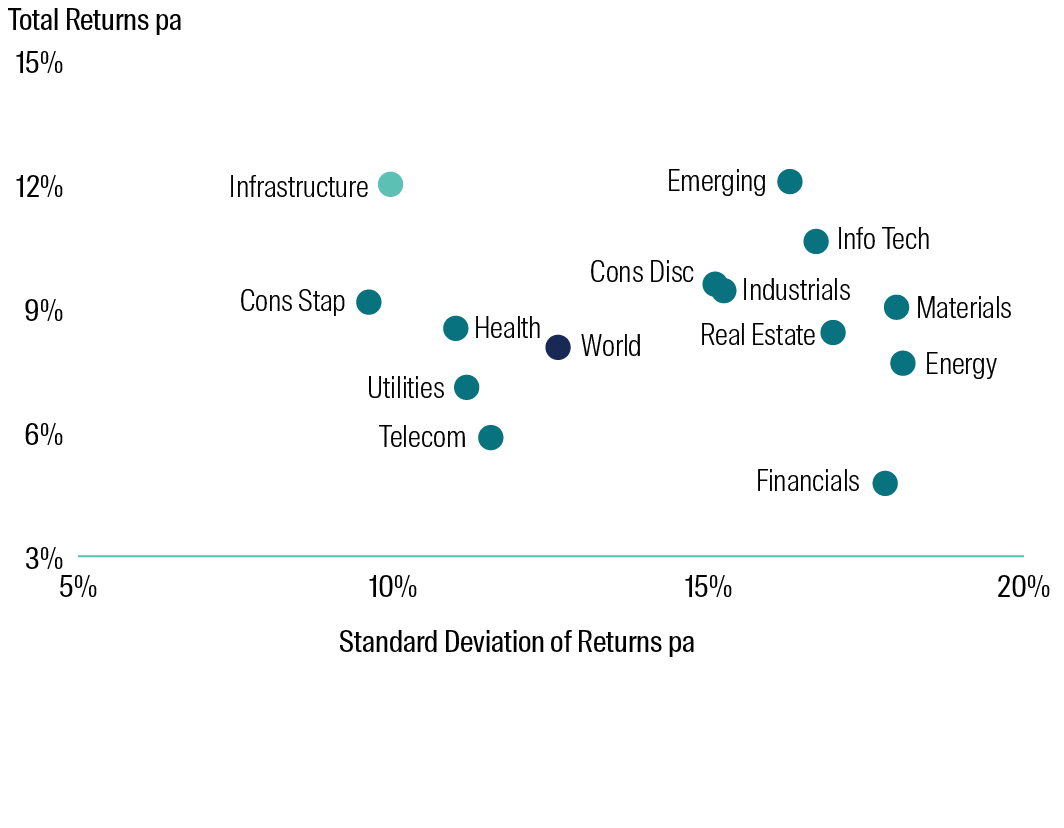
FTSE Global Core Infrastructure 50/50 Net TR Index AUD Hedged from Dec-05, previously Macquarie. MSCI World Net TR Local. Monthly data for 15 years to May-18. Source: Bloomberg and First Sentier Investors.
The sector has also proven to be defensive during periods of market volatility. In the past 15 years, the sector has provided over 80% of the upside in rising global equity markets but under 60% of the downside in falling markets.
Global Infrastructure in MSCI World Up/Down Markets
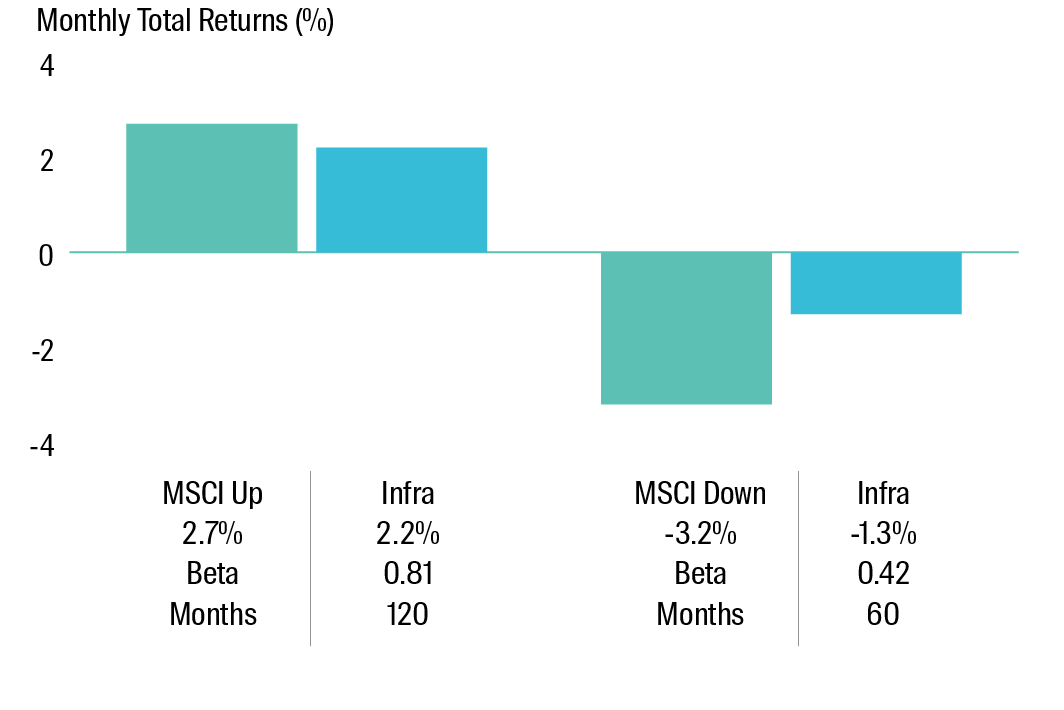
FTSE Global Core Infrastructure 50/50 Net TR Index AUD Hedged from Dec-05, previously Macquarie. MSCI World Net TR Local. Monthly data for 15 years to May-18. Source: Bloomberg and First Sentier Investors.
Global listed infrastructure may be suitable for investors who are looking for a more defensive investment during times of market volatility. Global listed infrastructure may also suit investors who are concerned about the impact of inflation and aim to ensure that their investments maintain and grow in real terms.
Myth 2: Infrastructure assets are low growth and will be left behind in rising markets
Infrastructure companies often generate growth from structural rather than cyclical drivers. Long-term trends like urban congestion, globalisation of trade, security of energy supplies, and mobility of communications have placed enormous strain on infrastructure networks and will require investment over many decades. Backed by the right business model, this investment has the potential to deliver strong capital growth for investors.
A number of infrastructure sectors are currently delivering double-digit growth due to structural change. Mobile towers have been a beneficiary of the exponential growth in smart phone usage and the resulting pressures on mobile carriers to improve network quality. American Tower has been increasing rental charges, co-locating new tenants on existing sites and building or acquiring new sites. Strict planning restrictions and community opposition to new tower sites represent effective barriers to entry. This has underpinned stable earnings growth at a compound annual growth rate (CAGR) of 15% over the 10 years to 2017, with further 4G and then 5G rollout to come.
Global listed infrastructure relative risk/return
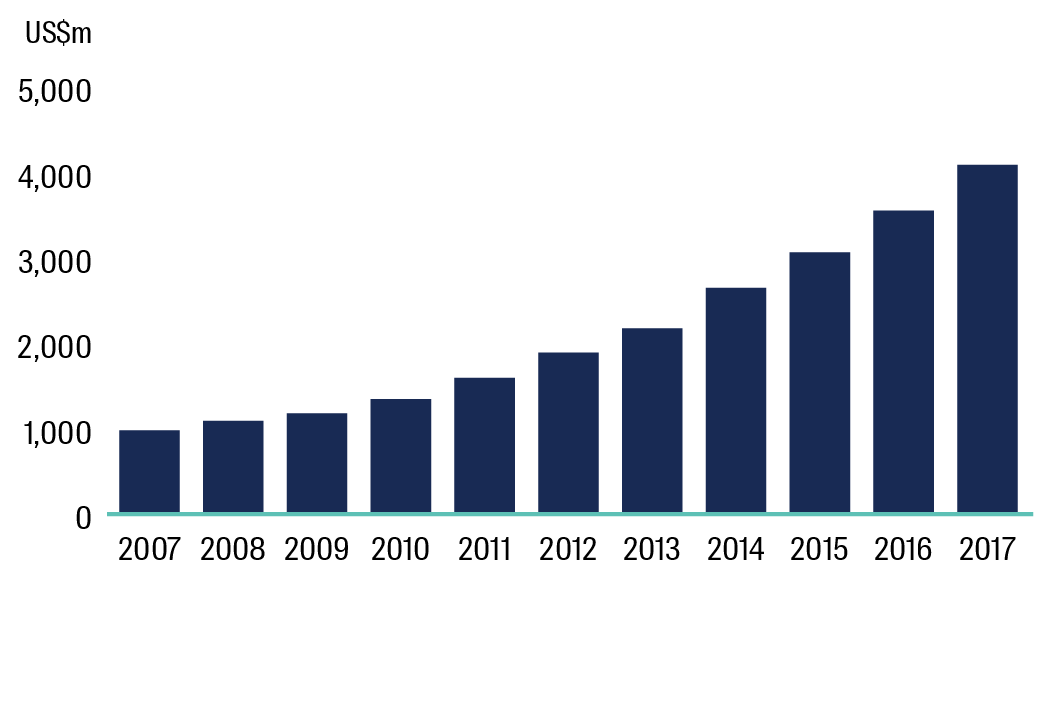
Source: First Sentier Investors as at June 2018, American Tower. 1 Earnings before interest, taxes, depreciation and amortization.
Listed infrastructure also offers exposure to sectors which have the potential to benefit from improving economic growth, such as ports and freight rail. Union Pacific, the largest North American Class I freight rail company, owns and operates a 32,000 mile network of railroads covering the western two thirds of the United States. The company effectively operates as a duopoly in its service territory, alongside Warren Buffet-owned BNSF.
The company has been a beneficiary of volume recovery as the US economy has improved. Earnings growth has been driven significantly by price increases and by improvements in operating efficiency. In addition to this, the company is under-levered, giving it the ability to buy back shares. In total, this combination of cyclical tailwinds and operational improvements enabled Union Pacific to achieve an Earnings per Share (EPS) compound annual growth rate of 15% pa as markets rose between 2009 and 2017.
Union Pacific 2009-2017 CAGR in EPS
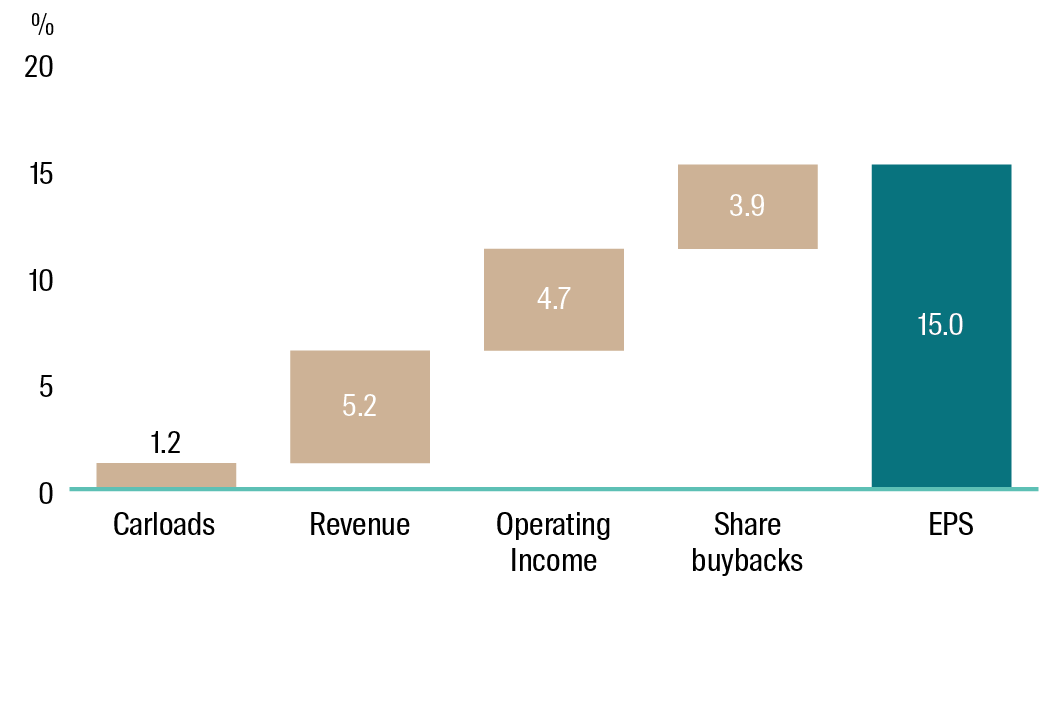
Source: Union Pacific, First Sentier Investors as at June 2018.
Myth 3: I already gain exposure to listed infrastructure through traditional equity managers
Many global equity managers may hold 2% or less of their portfolio in infrastructure assets, and this exposure could be concentrated amongst a small number of large, well-known utility names. However, much of the alpha generated in our diversified portfolio has come from mid cap stocks, which are underresearched by global equity managers, such as toll roads, oil storage, mobile towers and water utilities.
Listed infrastructure is an emerging asset class that is currently under-researched and not always well understood. This is similar to the situation we saw 20 years ago with listed property trusts, although we believe that the risk/return characteristics of listed infrastructure are superior to those of property, due to long-term structural growth drivers like urbanisation, globalisation of trade, mobilisation of data and security of energy supplies.
It is important to view investments in listed infrastructure from a global perspective. The global listed universe is capitalised at over US$2 trillion, allowing investors to diversify across various infrastructure sectors and geographies and to actively manage key risks.
A good example is the airport sector. Sydney Airport is one of the world’s leading airports in terms of profitability by passenger, but this is widely recognised and already fully reflected in the stock price – it trades at a 19x EV/EBITDA multiple. Alternatively, our Fund can buy shares in Spanish airport operator AENA, which is currently trading at 11x EV/EBITDA. At these levels we believe that AENA represents a better investment for our clients’ money.
Infrastructure is a separate asset class for many pension funds, endowment funds, sovereign wealth funds, private banks and multi-managers from around the world. Early movers are typically allocating between 5% and 10% to this asset class.
We have already received strong demand from private investors searching for an alternative to traditional asset classes. They recognise the need to move out of low yielding bonds into equities, but in many cases are wary of volatility. Listed infrastructure, with its combination of possible inflation protected income and the potential of steady capital growth, offers a way of doing this.
Myth 4: Infrastructure assets are too highly leveraged and therefore less defensive
There is no doubt that extreme levels of debt will change the characteristics of equity. A handful of infrastructure stocks, notably in Australia and Spain, created inappropriate capital structures (70-90% leverage) in the mid 2000’s when debt was cheap and plentiful. The one thing these companies had in common was poor alignment – investment banks or construction companies were often incentivised on a short-term deal or project rather than on the long-term viability of the investment.
It is important to note that these companies represented less than 5% of our global investment universe. The vast majority of infrastructure stocks are traditional companies, sensibly leveraged (30-50%) and run for shareholders. In recent years, they have strengthened balance sheets by reducing costs and repaying debt. We have also seen widespread refinancing of existing debt, to lock in reduced rates and diversify funding sources. The wave of share buybacks and bolt-on acquisitions suggest that many management teams now feel they are under leveraged.
Some poorly aligned companies took a back-to-basics approach. Australian toll road operator Transurban is a great example. Following changes in the Board and senior management earlier this decade, the company raised equity to repay debt, cut the dividend to sustainable levels, halved corporate costs and refocused on its core assets. Having undertaken these measures, Transurban became a key portfolio holding and delivered a total return of over 18% pa in the period from September 2011 to May 2018.
Today, global listed infrastructure companies are in sound financial positions. The cash yields of infrastructure sectors are higher than dividend yields, implying scope for payout ratios to be raised. This is especially the case for railroads and toll roads. This balance sheet strength suggests many companies have the potential to carry out share buy-backs, or to engage in merger and acquisition activity in order to boost earnings and dividends.
Infrastructure Yields by Sector
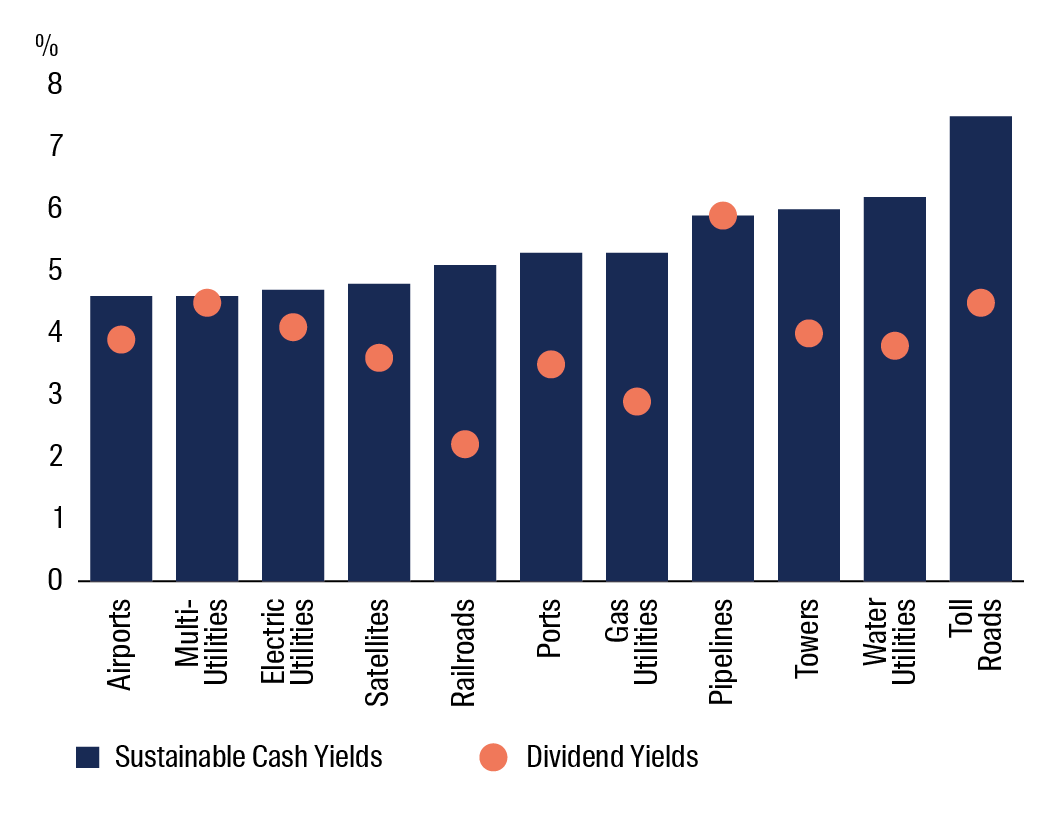
Source: First Sentier Investors as at June 2018, Bloomberg.
Myth 5: Infrastructure is reliant on government funding, which is in short supply
Following years of underinvestment, a significant amount of infrastructure investment is now needed globally. Rough estimates from the Organisation for Economic Co-operation and Development (OECD) suggest that annual investment requirements for road, rail, electricity (transmission and distribution), telecommunications and water are likely to total around an average of 2.5% of world GDP (roughly US$53 trillion to 2030)2. Economic growth for a number of nations has been hindered in by critical infrastructure bottlenecks, particularly in the transport sector.
However, while scarce government funding is problematic for societies in need of infrastructure upgrades, it is less of an issue for listed infrastructure companies. The listed infrastructure investment universe consists of mature,
established businesses. These companies provide essential services and generate predictable cash flows underpinned by regulated or contracted business models. Regulatory frameworks often encourage infrastructure companies to invest to maintain or improve their existing assets, and allow them to earn a return on money spent in this way. Under this model, infrastructure companies are incentivised to provide better and more efficient services; with no reliance on government help.
We have seen a lack of government funding lead to promising investment opportunities for listed infrastructure investors. Financially distressed governments have felt the need to divest assets, including valuable infrastructure, to help maintain financial stability. Airports have been listed on public markets or sold to listed companies in Japan, France, Spain and Greece; as have ports in China, Germany, Dubai and Greece. Australian state governments have sold port, toll road and electricity transmission assets to private operators.
A good example of this theme is AENA, the world’s largest airport operator. The company handles approximately 200 million passengers per year, primarily at 46 Spanish airports including hubs at Madrid and Barcelona. Previously wholly owned by the Spanish government, a 49% stake was IPO’d in early 2015. Since then the stock has risen strongly as robust passenger growth, limited capital expenditure requirements and improving commercial earnings have propelled its share price higher.
Looking ahead, the successful IPO of Ontario’s Hydro One offers a roadmap to the monetisation of other Canadian utilities, many of which remain in state government hands. Brazil is in the midst of a major privatisation program of toll roads, ports, railroads, airports and utilities.
Other significant potential transactions include the planned IPO of China’s mobile tower assets, whereby China’s three main telecom companies (China Mobile, Unicom, China Telecom) would spin off their tower assets into a new, separate entity (“China Tower Corp”). China Tower Corp would be responsible for the construction, maintenance and operation of China’s mobile tower networks, positioning it to gain from the structural growth in demand for
mobile data that US-listed peers American Tower and Crown Castle are already benefitting from.
In addition to this, the listed infrastructure investment universe is benefitting from a wave of corporate restructurings. Many infrastructure assets reside within large, vertically integrated corporations and conglomerates. Companies are increasingly looking to streamline and optimise their capital structures. This has often led to the divestment of infrastructure assets - highly valuable in their own right, but deemed peripheral by a larger entity.
Market Cap $bn
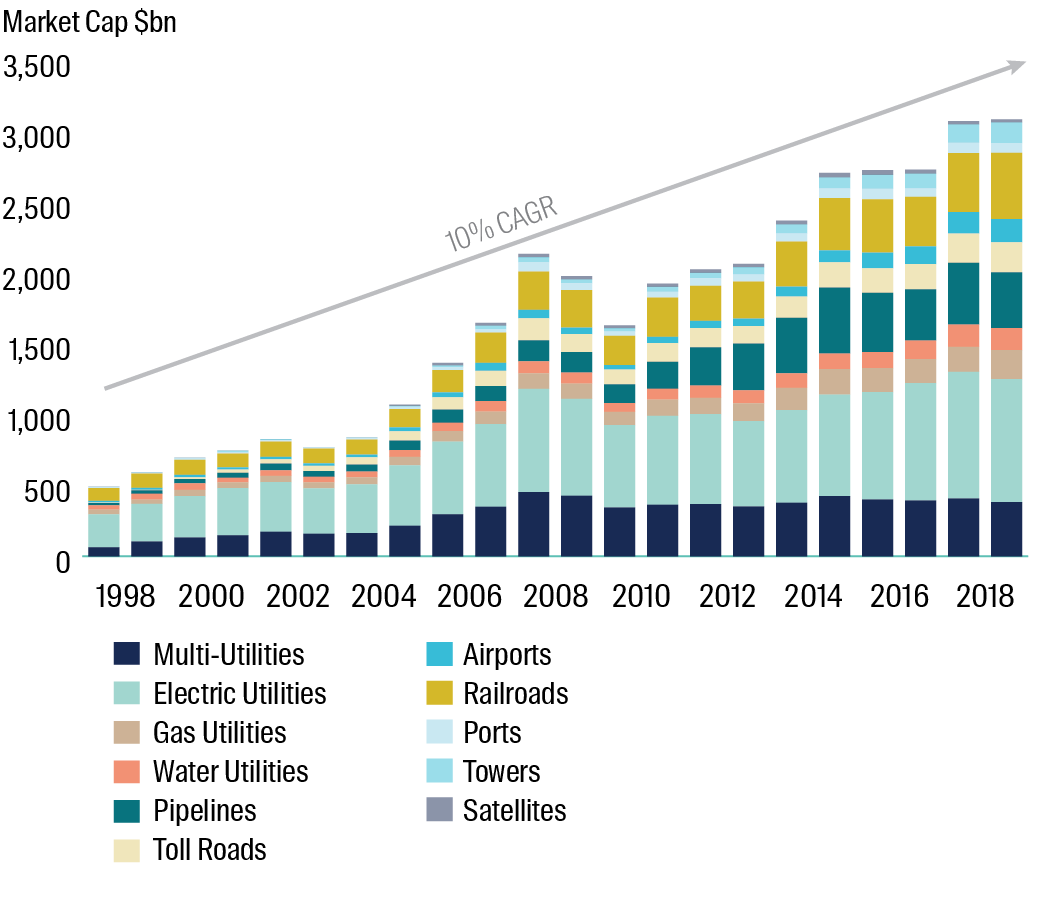
Source: Bloomberg, First Sentier Investors as at June 2018.
Combined, these themes of government privatisation and corporate restructuring have resulted in significant expansion, as well as improvements in quality and diversification, for the listed infrastructure asset class in recent years.
Important Information
This material has been prepared and issued by First Sentier Investors (Australia) IM Ltd (ABN 89 114 194 311, AFSL 289017) (Author). The Author forms part of First Sentier Investors, a global asset management business. First Sentier Investors is ultimately owned by Mitsubishi UFJ Financial Group, Inc (MUFG), a global financial group. A copy of the Financial Services Guide for the Author is available from First Sentier Investors on its website.
This material contains general information only. It is not intended to provide you with financial product advice and does not take into account your objectives, financial situation or needs. Before making an investment decision you should consider, with a financial advisor, whether this information is appropriate in light of your investment needs, objectives and financial situation. Any opinions expressed in this material are the opinions of the Author only and are subject to change without notice. Such opinions are not a recommendation to hold, purchase or sell a particular financial product and may not include all of the information needed to make an investment decision in relation to such a financial product.
To the extent permitted by law, no liability is accepted by MUFG, the Author nor their affiliates for any loss or damage as a result of any reliance on this material. This material contains, or is based upon, information that the Author believes to be accurate and reliable, however neither the Author, MUFG, nor their respective affiliates offer any warranty that it contains no factual errors. No part of this material may be reproduced or transmitted in any form or by any means without the prior written consent of the Author.
Get the right experience for you
Your location :  Australia
Australia
Australia & NZ
-
 Australia
Australia -
 New Zealand
New Zealand
Asia
-
 Hong Kong (English)
Hong Kong (English) -
 Hong Kong (Chinese)
Hong Kong (Chinese) -
 Singapore
Singapore -
 Japan
Japan

















 United Kingdom
United Kingdom 